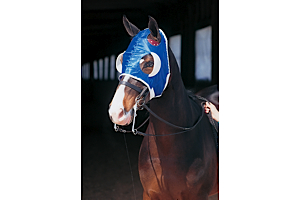-SWS wrote:
Are you sure she shouldn't increase EPAP just for good measure? I mean there is like zero apnea being seen, on her report.
Smarty canine pants!
If she manages to makes it into REM she just may have to.
I was ignoring that train wreck in the beginning of her report. But it is pretty hard to ignore:
at EPAP=9.0 she had zero apnea,
at IPAP avg=14 cm she ended up with an AHI=1.0,
at those settings her avg. tidal volume was 375ml, that is low either that or Bev is really short, if she is tall, that is still low.
But that 1st night was initial settings, that was to be expected, we basically wanted to learn if lower pressure kept obstructive events away, that it did show. So with EPAP at 9 cm, and avg. IPAP at 14cm that is 5 cm Pressure Support as determined by the SV.
So when you look at that Encore report and initial settings, what needs to be fixed?
-AHI=1.0 is certainly acceptable AHI, only one aspect of this person's sleep.
-99% Patient initiated breaths is good, can it be better? I think so.
-Avg Tidal Volume seen is 375ml, low unless you are a midget, dangit Bev how tall are ya anyway?
Soo armed with that info, where do you go next? Well I see it as:
Can't increase EPAP quiet yet as there are no Apnea seen (give me a reason why it would need to be increased), machine reported it wanted to use 14 cm as IPAP avg, meaning the SV thought 5 cm pressure support was adequate for that session. Well let's decrease the work IPAP working has to do, move IPAP Min higher, should add more breathing comfort and it would only have to move 1 cm to avg out with what it did last night.
Sure If we wanted to control/lower where IPAP was heading or rising too, we could increase EPAP but I suspect things will only fall apart faster as they did during her lab titrations. But it might eliminate those residual 3-5 Hypopnea seen during that 8.5 hr period. Actually, I see those 3-5 HI's a bit high for the SV, most the reports I've seen it completely eliminated HI's.
The SV pegged her BPM at 14.6. You will notice on her Encore report where those 3 sets of Hypopnea showed up her BPM (in auto mode) went down to 10 BPM, IPAP working pressure went up about 19 cm to address those Hypopnea. So there that BPM=10 shows up again even in the SV algorithm.
I'd still like to see her find settings that increase her tidal volume closer to 500ml cause I know she's not a midget
Bev, out of that third session of 6.5 hrs did you land any sleep in that period at all? I know you don't feel like it, but I suspect you were in some kind of sleep during therapy hour 5 thru 8?
I think once we get some pressure support built-in she will start feeling better. Her pressure support may even have to go higher than what
the SV wants to almost address UARS, now ain't that complex.
So SWS, does the SV protocol consider those HI's seen on Bev's report as "obstructive" events? ...meaning do they want EPAP to also completely eliminate those? and IPAP then only targets peak flows and tidal volume? I could believe that, but I don't think its the case.
someday science will catch up to what I'm saying...













